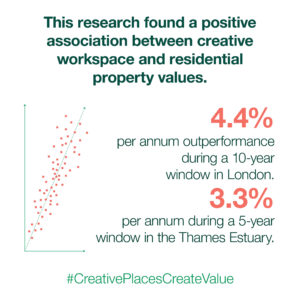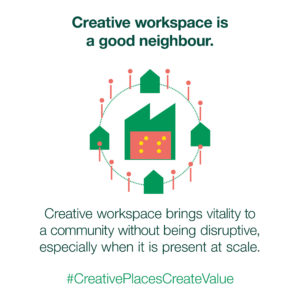Creative Land Trust, in collaboration with Get Living and Creative Estuary, has published research that has found a positive association between the presence of creative workspace and residential property values.
The evidence – including case studies from the Thames Estuary – suggests there is a financial value to the benefits that creative industries bring to residential areas, expressed in house price data.
Over a 10-year time frame this amounted to 4.4 per cent per annum price outperformance above the wider London residential market – a total of 44 per cent over the 10 years. The per annum outperformance ranged from a high of 10 per cent per annum (London City Island) through to 2 per cent per annum (Fish Island, Hackney Wick).

The research uses house price data in various locations recognised as clusters of creative workspaces, analysed over various time frames, to identify the level of outperformance in house price data relative to the wider market.
It focuses on case studies of creative clusters in London (Hackney Wick, Woolwich Dockyard and Tottenham) and the Thames Estuary (Margate, Southend, Basildon, Thurrock and Medway), and standalone schemes where creative workspace had been included in a residential scheme in London (Galleria in Peckham, Bow Arts in Royal Albert Docks, ASC Arthouse in Croydon and Second Floor Studios in Wembley).
The outperformance in residential values is comparable to the local economic effect associated with large-scale urban regeneration, green or blue spaces, popular schools, or certain grocery stores being adjacent to homes.
The risk analysis in this research also demonstrates that creative workspace as a ground floor use in a residential development does not introduce any additional risk and can increase investment value where there is a good covenant and secure long-term income (or a long leasehold sale). Therefore, the report says that professionally managed creative workspace is often a more viable and financially attractive option than other commercial uses because it offers long-term secure income, particularly appealing in uncertain times.

Gordon Seabright, Chief Executive of Creative Land Trust, commented: “The ultimate purpose of this research study is to help expand the provision of affordable workspace for creatives by presenting developers with evidence to show that creative workspace can make an important contribution to financial value in a residential-led development.
Kate Willard OBE, Estuary Envoy said: “We are huge believers in the value that creative spaces have on making great places to live. I am delighted that this research by Creative Land Trust, in collaboration with Get Living and Creative Estuary quantifies that value.”
Ken Dytor, Director of Urban Catalyst and Thames Estuary Growth Board Lead for Inward Investment: “Our view is that creative engagement has enormous impact, it is difficult to measure, but we recognise the value as massive and work alongside developers and investors who recognise this, as we do, with a different mindset and approach.”
Emma Wilcox, Project Director of Creative Estuary, commented: “It has long been acknowledged that cultural and creative industries can bring vibrancy and economic growth to an area. In many cases this growth has been organic. Successful places attract demand for housing and in a market economy with constrained supply, demand almost inevitably translates into rising property values, which has the potential to displace creative workspace and disrupt creative communities. Through our work at Creative Estuary, we are exploring new models and partnerships to ensure our industry continues to thrive.”
